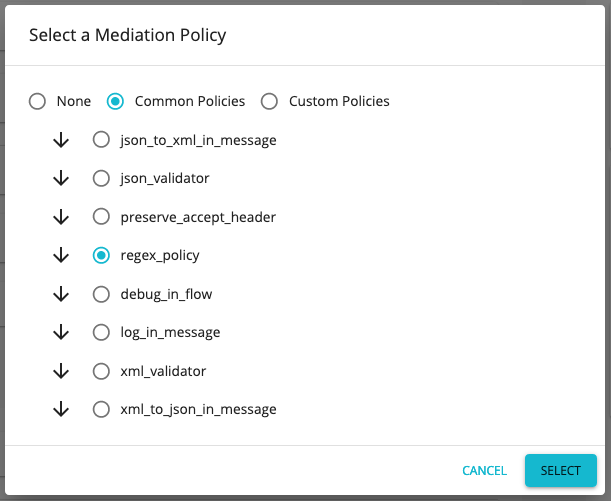Regular Expression Threat Protection for API Gateway¶
WSO2 API Manager provides pre-defined regex patterns to sanitize the request from SQL injection attacks. The attacks may depend on the API traffic at runtime. The API developers should identify the common attacks and select the appropriate restrictive measures. This feature extracts the data from XML, JSON payloads, Queryparam, URI path, headers and validates the content against pre defined regular expressions. If any predefined regex keyword is matched with the content, the API request is considered as a threat and it is blocked and rejected. This secures the backend resources from activities that make the system vulnerable. You can configure your own restriction patterns to thwart various attacks such as the following:
- Javascript Injection
- Server-side Include Injection
- XPath Injection
- Java Exception Injection
- XPath Abbreiviated Syntax Injection
Blacklisting patterns¶
We recommend the following patterns for blacklisting.
| Name | Patterns |
|---|---|
| SQL Injection |
.*'.*|.*ALTER.*|.*ALTER TABLE.*|.*ALTER VIEW.*|.*CREATE DATABASE.*|.*CREATE PROCEDURE.*|.*CREATE SCHEMA.*|.*create table.*|.*CREATE VIEW.*|.*DELETE.*|.*DROP DATABASE.*|.*DROP PROCEDURE.*|.*DROP.*|.*SELECT.*
|
| Server-side Include Injection Attack |
.*#include.*|.*#exec.*|.*#echo.*|.*#config.*
|
| Java Exception Injection |
.*Exception in thread.*
|
| XPath Injection |
.*'.*|.*or.*|.*1=1.*|.*ALTER.*|.*ALTER TABLE.*|.*ALTER VIEW.*|.*CREATE DATABASE.*|.*CREATE PROCEDURE.*|.*CREATE SCHEMA.*|.*create table.*|.*CREATE VIEW.*|.*DELETE.*|.*DROP DATABASE.*|.*DROP PROCEDURE.*|.*DROP.*|.*SELECT.*
|
| Javascript Exception |
|
| XPath Expanded Syntax Injection |
|
Editing the sequence through registry artifacts¶
To edit the existing sequence follow the steps below.
- Log in to the Management Console.
- Navigate to
/_system/governance/apimgt/customsequences/in/regex_policy.xml - Edit the
regex_policy.xmlfile. - Go to the API Publisher and re-publish your API for the changes to take effect.
Applying the Regular Expression Policy¶
You can apply the pre-defined Regular Expression Policy through the UI. Follow the instructions below to apply the regex_policy in sequence.
- Create an API or edit an existing API.
- Go to Message Mediation Policies under Request configurations of the Runtime Configurations tab.
- Select Edit in the message mediation bar and select Common Policies .
-
Select
regex_policyfrom the drop-down menu for Common Policies. -
Scroll down the page and click Save to save the changes.
Each request is sanitized through the regular expression threat protector. You can add or modify the regex patterns according to your requirement.
The regex_policy sequence is given below.
<sequence xmlns="http://ws.apache.org/ns/synapse" name="regex_policy">
<log level="custom">
<property name="IN_MESSAGE" value="Regular_expression_policy"/>
</log>
<property name="threatType" expression="get-property('threatType')" value="SQL-Injection"/>
<property name="regex" expression="get-property('regex')" value=".*'.*|.*ALTER.*|.*ALTER TABLE.*|.*ALTER VIEW.*|
.*CREATE DATABASE.*|.*CREATE PROCEDURE.*|.*CREATE SCHEMA.*|.*create table.*|.*CREATE VIEW.*|.*DELETE.*|.
*DROP DATABASE.*|.*DROP PROCEDURE.*|.*DROP.*|.*SELECT.*"/>
<property name="enabledCheckBody" expression="get-property('checkBodyEnable')" value="true"/>
<property name="enabledCheckHeaders" expression="get-property('enabledCheckHeaders')" value="true"/>
<property name="enabledCheckPathParams" expression="get-property('enabledCheckPathParams')" value="true"/>
<class name="org.wso2.carbon.apimgt.gateway.mediators.RegularExpressionProtector"/>
</sequence>Note
If you need to validate only the request headers, you can disable the enabledCheckBody and
enabledCheckPathParams properties by setting the value to false .
Testing the regex threat protector¶
You can test this feature by sending an SQL injection attack with the XML message body. The sample request and response is given below.
<?xml version="1.0" encoding="UTF-8"?>
<breakfast_menu>
<food>
<name>Homestyle Breakfast</name>
<price>drop table</price>
<description>
Two eggs, bacon or sausage, toast, and our ever-popular hash browns
</description>
<calories>950</calories>
</food>
</breakfast_menu><am:fault xmlns:am="http://wso2.org/apimanager">
<am:code>400</am:code>
<am:message>Bad Request</am:message>
<am:description>SQL-Injection Threat detected in Payload</am:description>
</am:fault>Warning
Performance impact
The regex mediator builds the entire message and performs string processing to find potentially harmful constructs
underneath the message body. This drops the performance of 10KB messages for 300 concurrent users by 3.6 times than
the normal flow. The performance decrease may accelerate along with the message size.
